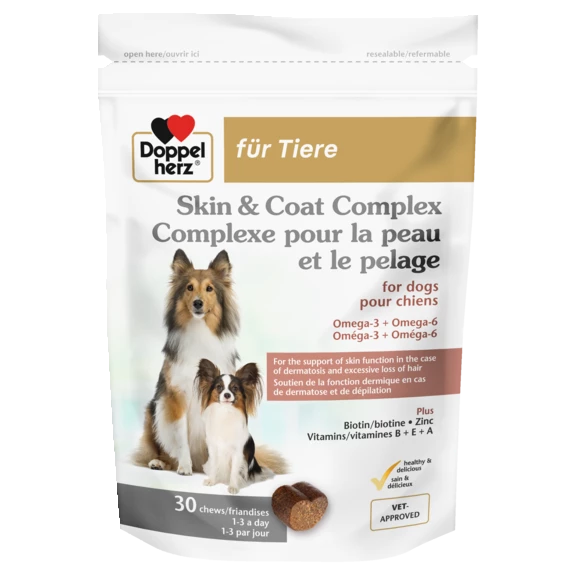In most dogs, the coat is the most prominent visible feature as, with few exceptions, it completely covers and protects the skin. However, the coat can only be as healthy as the skin underneath. And this is a complex organ with many layers, functions and needs.
Structure and functions of the skin in dogs
As in humans and many other mammals, the skin of dogs consists of several layers and protects the body and its organism from potentially harmful external influences, e.g. chemical substances and microorganisms that could otherwise enter the body unhindered. At the same time, it is the largest of all organs in mammals and also serves as a sensory organ, as there are countless nerve endings in and under the skin that transmit information about cold, heat and pain to the brain.
The epidermis forms the outermost layer of skin, which is also visible through the coat. Underneath is the dermis, the thickest layer of skin. The subcutis is a layer of loose connective tissue and fat.
The epidermis
The outermost layer of skin is called the epidermis. In the lower level of the epidermis are pigment -forming cells that give skin and coat their colours. The colour and distribution of the pigments emitted are largely determined in the dog's genetic make-up. However, age, diseases and sun exposure can also influence the colour of the coat. For example, the phenomenon of the so-called "changing nose" can be observed in some dogs: UV radiation from the sun causes increased production of colour pigments. This causes the otherwise light-coloured nose to darken in the dogs concerned. This endogenous mechanism protects the skin from radiation-induced damage such as sunburn during the sunny months. Stress and the natural ageing process of the dog, on the other hand, lead to a gradual death of the colour-producing cells, which finally manifests itself in an increasing greying and in an increased sensitivity to the sun.
In the epidermis there are also numerous cells that migrate to the surface of the skin after their formation, die and in the process increasingly harden into small, firm horny scales. The top layer of skin thus consists of several layers of these horny cells. As a result, they form a kind of protective coat of keratin, which is much thicker on hairless areas such as the paw. The more a part of the body is stressed, the stronger the horny coat becomes. Age also contributes to the growth of the horn coat.
This horny layer protects against mechanical and chemical stress and also ensures protection against the penetration of harmful microorganisms (e.g bacteria). In addition, the skin barrier prevents fluid loss.
In puppies, the skin barrier is often even more permeable than in adult dogs.
The dermis
The middle layer of the skin, called the dermis, consists of dense yet very elastic tissue. This makes for an overall flexible and resistant skin. With increasing age, both properties decrease.
The numerous blood vessels of the dermis supply the overlying epidermis with nutrients. Another important task of these blood vessels is the regulation of the skin and body temperature. In hot conditions, the veins dilate to release more heat. In cold conditions, on the other hand, they contract for less heat loss. There are particularly many sensory cells in the dermis. They are responsible for receiving and transmitting various environmental stimuli. Different cells exist depending on the type of stimulus. These are specialised in sensations such as touch, pain, itching, cold or warmth.
A certain type of muscle, the hair follicle muscle, is also located in the middle layer of the skin. Stress hormones cause these muscle fibres to tense, causing the dogs' fur to stand up, especially in the neck and back area. The erect hairs are a reflex - a reaction that cannot be consciously controlled by the dog and is triggered by stress or tension.

The subcutis
The third layer of skin, called the subcutis, consists mainly of fat cells. These insulate the dog's body and thus protect it from the cold. Besides energy, vitamins are also stored in the fatty tissue of the subcutis. In addition, the fat serves as protection for the organs inside the body against shocks and pressure.
The skin glands
There are different types of glands in the upper layers of the skin. Sebaceous glands secrete a greasy substance that forms a thin, water-repellent laver on the skin. This protects the skin from pollutants and pathogens and also gives the coat its natural shine. Many of these sebaceous glands are found especially at the base of the tail.
Two other types of glands found in the dog's skin are the apocrine and eccrine glands. Apocrine glands are found on almost the entire body. They secrete a protein-rich secretion that combines with the skin sebum to improve the protective properties of the greasy film. The apocrine glands also have a communicative function through the production of scents. The eccrine glands are mainly located on the pads of the paws. They are similar to human sweat glands and secrete an odourless clear liquid.
Tasks and condition of the dog's coat
Every dog has a coat typical of its breed, or in the case of mixed breeds, a combination of the characteristics of several breeds. But whether short-haired, rough-haired, long-haired or stick-haired - the coat takes on important tasks in every dog: It protects the skin or the body from external influences. In addition to intercepting weather influences such as moisture or cold, the coat also helps to keep parasites away from the sensitive skin. In most dogs, there are two different types of hair within the coat: the top coat and the undercoat.
Certain dog breeds have a particular coat structure. If, for example, the undercoat is missing, certain care and protective measures, such as putting on a dog coat, can be useful. Also, if the function of the skin as a protective cover is disturbed by infections or injuries, the health of the skin should be additionally supported.
But the skin's function can also be attacked from the inside: Diseases and allergies, as well as an oversupply or undersupply of certain nutrients, also influence the health and defense function of the skin. Therefore, a sufficient and balanced supply of nutrients such as essential fatty acids, biotin, zinc and amino acids should always be ensured in order to maintain the natural health of the skin.
